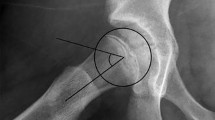Abstract
Objective
Prophylactic fixation of the contralateral hip in slipped capital femoral epiphysis (SCFE) is controversial, and no reliable method has been established to predict subsequent contralateral slip. The main purpose of this study was to evaluate if magnetic resonance imaging (MRI) performed at primary diagnosis could predict future contralateral slip.
Materials and methods
Twenty-two patients with unilateral SCFE were included, all had MRI of both hips taken before operative fixation. Six different parameters were measured on the MRI: the MRI slip angle, the greatest focal widening of the physis, the global widening of the physis measured at three locations (the midpoint of the physis and 1 cm lateral and medial to the midpoint), periphyseal (epiphyseal and metaphyseal) bone marrow edema, the presence of pathological joint effusion, and the amount of joint effusion measured from the lateral edge of the greater trochanter. Mean follow-up was 33 months (range, 16–63 months). Six patients were treated for contralateral slip during the follow-up time and a comparison of the MRI parameters of the contralateral hip in these six patients and in the 16 patients that remained unilateral was done to see if subsequent contralateral slip was possible to predict at primary diagnosis.
Results
All MRI parameters were significantly altered in hips with established SCFE compared with the contralateral hips. However, none of the MRI parameters showed any significant difference between patients who had a subsequent contralateral slip and those that remained unilateral.
Conclusions
MRI taken at primary diagnosis could not predict future contralateral slip.





Similar content being viewed by others
References
Wilson PD, Jacobs B, Schecter L. Slipped capital femoral epiphysis: an end result study. J Bone Joint Surg Am. 1965;47:1128–45.
Hägglund G, Hansson LI, Ordeberg G, Sandström S. Bilaterality in slipped upper femoral epiphysis. J Bone Joint Surg Br. 1988;70:179–81.
Carney BT, Weinstein SL, Noble J. Long-term follow-up of slipped capital femoral epiphysis. J Bone Joint Surg Am. 1991;73:667–74.
Stasikelis PJ, Sullivan CM, Phillips WA, Polars JA. Slipped capital femoral epiphysis. Prediction of contralateral involvement. J Bone Joint Surg Am. 1996;78:1149–55.
Loder RT. The demographics of slipped capital femoral epiphysis. An international multicenter study. Clin Orthop Relat Res. 1996;322:8–27.
Yildirim Y, Bautista S, Davidson RS. Chondrolysis, osteonecrosis, and slip severity in patients with subsequent contralateral slipped capital femoral epiphysis. J Bone Joint Surg Am. 2008;90:485–92.
Wensaas A, Svenningsen S, Terjesen T. Long-term outcome of slipped capital femoral epiphysis: a 38-year follow-up of 66 patients. J Child Orthop. 2011;5:75–82.
Lehmann TG, Engesæter IØ, Laborie LB, Rosendahl K, Lie SA, Engesæter LB. In situ fixation of slipped capital femoral epiphysis with Steinmann pins: 67 patients followed for 2-16 years. Acta Orthop. 2011;82:333–8.
Popejoy D, Emara K, Birch J. Prediction of contralateral slipped capital femoral epiphysis using the modified Oxford bone age score. J Pediatr Orthop. 2012;32:290–4.
Umans H, Liebling MS, Haramati N, Macy NJ, Pritzker HA. Slipped capital femoral epiphysis: a physeal lesion diagnosed by MRI, with radiographic and CT correlation. Skelet Radiol. 1998;27:139–44.
Futami T, Suzuki S, Seto Y, Kashiwagi N. Sequential magnetic resonance imaging in slipped capital femoral epiphysis: assessment of preslip in the contralateral hip. J Pediatr Orthop B. 2001;10:298–303.
Tins B, Cassar-Pullicino V, McCall I. The role of pre-treatment MRI in established cases of slipped capital femoral epiphysis. Eur J Radiol. 2009;70:570–8.
Lalaji A, Umans H, Schneider R, Mintz D, Liebling MS, Haramati N. MRI features of confirmed “pre-slip” capital femoral epiphysis: a report of two cases. Skelet Radiol. 2002;31:362–5.
Loder RT, Richards BS, Shapiro PS, Reznick LR, Aronson DD. Acute slipped capital femoral epiphysis: the importance of physeal stability. J Bone Joint Surg Am. 1993;75:1134–40.
Southwick WO. Osteotomy through the lesser trochanter for slipped capital femoral epiphysis. J Bone Joint Surg Am. 1967;49:807–35.
Ziebarth K, Zilkens C, Spencer S, Leunig M, Ganz R, Kim YJ. Capital realignment for moderate and severe SCFE using a modified Dunn procedure. Clin Orthop Relat Res. 2009;467:704–16.
Harris WH. Traumatic arthritis of the hip after dislocation and acetabular fractures: treatment by mold arthroplasty: an end-result study using a new method of result evaluation. J Bone Joint Surg Am. 1969;51:737–55.
McGraw KO, Wong SP. Forming inferences about some intraclass coefficients. Psychol Meth. 1996;1:30–46.
Cohen J. Weighted kappa: nominal scale agreement with provision for scaled disagreement or partial credit. Psychol Bull. 1968;70:213–20.
Altman DG. Practical statistics for medical research. London: Chapman & Hall. 1991;403–9.
Loder RT, Wittenberg B, DeSilva G. Slipped capital femoral epiphysis associated with endocrine disorders. J Pediatr Orthop B. 1995;19:349–56.
Riad J, Bajelidze G, Gabos PG. Bilateral slipped capital femoral epiphysis. Predictive factors for contralateral slips. J Pediatr Orthop. 2007;27:411–4.
Azzopardi T, Sharma S, Bennet GC. Slipped capital femoral epiphysis in children aged less than 10 years. J Pediatr Orthop B. 2010;19:13–8.
Barrios C, Blasco MA, Blasco MC, Gascó J. Posterior sloping angle of the capital femoral physis. A predictor of bilaterality in slipped capital femoral epiphysis. J Pediatr Orthop. 2005;25:445–9.
Author information
Authors and Affiliations
Corresponding author
Ethics declarations
Conflict of interest
The authors declare that they have no conflicts of interest
Appendix
Appendix
Rights and permissions
About this article
Cite this article
Wensaas, A., Wiig, O., Hellund, J.C. et al. Magnetic resonance imaging at primary diagnosis cannot predict subsequent contralateral slip in slipped capital femoral epiphysis. Skeletal Radiol 46, 1687–1694 (2017). https://doi.org/10.1007/s00256-017-2735-1
Received:
Revised:
Accepted:
Published:
Issue Date:
DOI: https://doi.org/10.1007/s00256-017-2735-1




